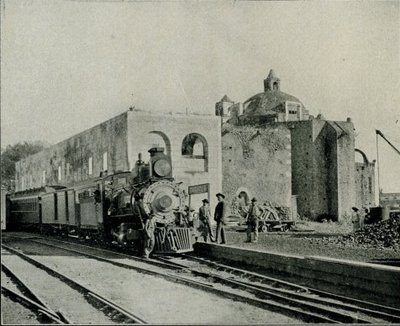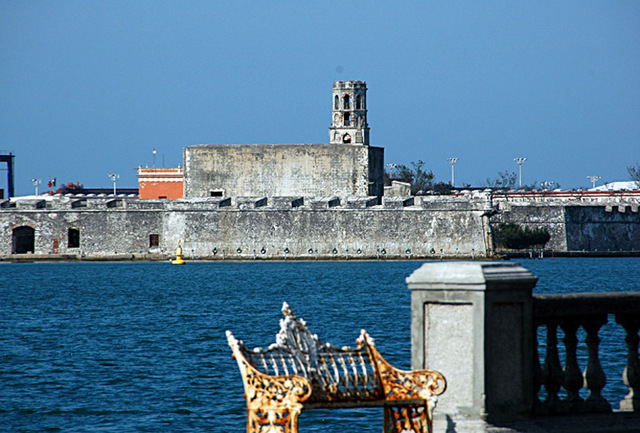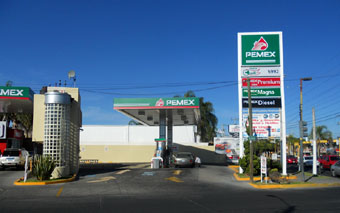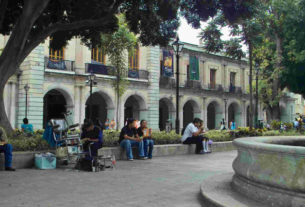During the month of March . . .
THE START OF 70 YEARS IN POWER
PANCHO VILLA ATTACKS THE U.S.
GRAIN PRICES SPARK REVOLT
OIL COMPANIES NATIONALIZED
TRAIN + DYNAMITE = WEAPON
SURRENDER OF VERACRUZ
1, 1521 Cuauhtemoc, the last Aztec emperor, is crowned, without fanfare. Tradition dictates that he has to marry and he does so, with his cousin Teucipoh.
1, 1845 The U.S. Congress approves the annexation of Texas and chooses the Rio Bravo as its southern limit.
2, 1897 Guillermo Prieto (born Mexico City February 10, 1818,) dies in Mexico City. Prieto was an illustrious writer, historian and politician who saved the life of Benito Juárez on March 14, 1858, when he faced the rebels and cried, “Halt! Brave people don’t carry out assassinations”.
3, 1528 Diego de Mazariegos founds the first Spanish settlement in the Chiapas region, calling it Chiapa de los Indios.
THE START OF 70 YEARS IN POWER
4, 1929 A new political party, the National Revolutionary Party (Partido Nacional Revolucionario), is founded, with the support of President Elias Calles who wants to attract all the revolutionary forces. The party later changes its name to the Institutional Revolutionary Party (Partido Revolucionario Institucional, PRI) and remains in power until the year 2000.

5, 1812 The formal beginning of the Siege of Cuautla during which Royalist forces, commanded by Calleja y Llano, surround the city of Cuautla, defended by Morelos. The siege lasts 58 days until it is finally broken on May 2.
6, 1877 The National Astronomical Observatory is founded by Mariano Barcena and equipped with the most modern equipment available. The previous “observatory” had been located on a balcony of the National Palace.
6, 1946 Antonio Caso (born December 19, 1885) dies in Mexico City. Caso was an illustrious lawyer, philosopher and academic, who became the first Secretary, and later Rector, of the National University.
7, 1836 In the war against Texas, General Santa Anna takes the fort of El Alamo in San Antonio and orders all survivors shot.
PANCHO VILLA ATTACKS THE U.S.
9, 1916 Francisco Villa makes a surprise attack at dawn on Columbus, New Mexico. Villa’s foolhardy incursion results in retaliation on March 14 when General John Pershing enters Mexico with a “Punitive Expedition” to hunt for Villa. Pershing’s expedition remains in Mexico until February 6, 1917. Expedition members include Dwight D. Eisenhower.
10, 1911 Emiliano Zapata begins a rebellion in the state of Morelos to protest the fact that large landowners are dispossessing peasant farmers (campesinos) of their land.
11, 1850 U.S. Captain Love makes the first expedition along the length of the Rio Bravo.
11, 1916 Venustiano Carranza arrives in Mexico City, where he establishes a provisional government, with himself at its head.
GRAIN PRICES SPARK REVOLT
12, 1697 The populace revolts in Mexico City in response to an excessive rise in the price of basic grains.
12, 1911 Gustavo Díaz Ordaz is born in San Andrés Chalchicomula, (now known as Ciudad Serdán) in Puebla. A lawyer and politician, he serves a term as President from 1964 to 1970.
13, 1325 The date on which Tenochtitlan is believed to have been founded by a wandering group of Méxica Indians, who had set out from Aztlán about 150 years previously. They had been looking for an eagle perched on a prickly pear (nopal) cactus. The city became the Aztec capital, center of an extensive Empire, and was later transformed into Mexico City.

13, 1847 The U.S. Squadron takes control of the port of Veracruz, after which General Winfield Scott demands that the local authorities surrender the port. They refuse and a naval bombardment begins.
14, 1565 The first Bishop of Michoacán, Vasco de Quiroga, dies in Uruapan, Michoacán. Born in Spain on February 3, 1470, Vasco de Quiroga was appointed Bishop shortly after his arrival in New Spain. He was a great supporter of Indian rights and founded numerous hospitals, schools and orphanages as well as organizing the production of crafts in the numerous villages around Lake Pátzcuaro.
15, 1711 Father Francisco Eusebio Kino dies in Magdalena, Sonora. A tireless evangelist and educator, he led explorations of the virtually unknown areas that are, today, the states of Sinaloa, Sonora and Arizona, founding numerous missions as he went.
15, 1861 The government of President Benito Juárez decrees the use of the metric system throughout Mexico, as of January 1, 1862. Decimal coinage is minted for the first time. Another President (Comonfort) had already forced engineers to use the metric system, four years previously. Later governments do not insist on decimalization and further decrees are issued in 1882 by President Manuel González and 1896 by President Porfirio Díaz.
16, 1586 King Philip II of Spain, orders the missionaries of New Spain to educate the Indians not out of charity but out of a sense of justice and obligation.
17, 1900 President Porfirio Díaz inaugurates the Valley of Mexico drainage project by opening the sluice gates in La Merced-Balbuena. The drainage scheme had been initiated four centuries earlier.
17, 1917 Mexico declares its neutrality in the First World War.
18, 1541 The city of Valladolid (which was later renamed Morelia) was founded by the Viceroy, Antonio de Mendoza, in the Guayangareo valley in Michoacan. The city quickly became the state capital.
OIL COMPANIES NATIONALIZED

18, 1938 The nationalization (or expropriation, depending on your point of view) of the oil industry in Mexico by President Lázaro Cárdenas. The move came in response to salary discrimination and the refusal of foreign companies to pay higher taxes. The first Director of the nationalized industry (PEMEX) was the engineer Victor Cortés Herrera.
20, 1779 The Viceroy Antonio María Bucareli inaugurates the Chapultepec-Salto del Agua aqueduct, on which work had begun in 1711. Some parts of the aqueduct can still be seen in Mexico City today.
21, 1806 Benito Juárez García is born in the village of San Pablo Guelatao, in the state of Oaxaca. Juárez becomes a distinguished and patriotic President of Mexico, loyal to the rights of all peoples and all nations, and dedicated to the pursuit of national justice and sovereignty.
21, 1916 Juan García Jiménez is born in Ometepec, Guerrero. He becomes well known as a poet and teacher of literature in the National Teachers’ School in Mexico City. His death comes on April 1, 1967.
22, 1803 The corvette “Pizarro” docks in Acapulco after a voyage from Peru and Ecuador. Aboard are two people who will transform the course of science in Mexico: the German explorer and geographer Baron Alexander von Humboldt and the French doctor-turned-botanist Aimé Bonpland.
22, 1884 The Central Mexican Railroad (Ferrocarril Central Mexicano) is inaugurated, providing service between Mexico City and Ciudad Juárez, Chihuahua.
22, 1923 Alberto Beltrán is born in Mexico City. He wins renown as an excellent draftsman, engraver and designer.
23, 1849 The death, in Mexico City of scientist Andrés del Río (born November 10, 1765, in Spain). On his arrival in Mexico in 1793, he had taken a post as Chemistry professor in the Mining School. In 1800 he discovered the element vanadium. Honored by several foreign scientific societies, he took Mexican citizenship in the 1820s.
25, 1868 The government of the state of Jalisco, influenced by public education in Mexico City, passes an Education Law that omits religious education and requires the teaching of civics and of a compendium of national history and geography.
TRAIN + DYNAMITE = WEAPON
25, 1912 Emilio Campa, a member of Pascual Orozco’s troops, attacks the federal troops of Madero in Rellano, Chihuahua, by sending a dynamite-laden train into them. Many are killed and Madero’s forces beat a retreat towards Torreón, Coahuila.
26, 1814 The port of San José de Guaymas (now Guaymas, Sonora) is opened for domestic traffic. In February 1822, its role is expanded to include international shipping.
26, 1944 The Revolutionary general and engineer, Wilfrido Massieu dies in Mexico City, where he had been born December 27, 1879. Massieu was director of the Industrial School in San Luis Potosí. He promoted and founded the Industrial Institute. Concerned about the slow development of technology in the country, he later fought for the founding (in 1937) of the National Polytechnic Institute, becoming the Institute’s first Director.
27, 1853 General Antonio López de Santa Anna is declared President for the eleventh time. He assumes office on April 20 and remains in power until August 12, 1855.
SURRENDER OF VERACRUZ
28, 1847 After six days, the U.S. forces end their bombardment of the port of Veracruz. Despite valiant resistance, the port is forced to surrender. Its inhabitants’ heroic efforts result in the city being adjudged “Heroico” for the second occasion.
28, 1944 Foundation of the National Newspaper and Periodical Library. It is originally housed in the San Pedro y San Pablo church, before moving in 1979 to its present location in the National University.
29, 1732 Circular coins, with the Royal coat of arms and fleur-de-lis around the edge, are minted for the first time in Mexico.
29, 1982 The El Chichón volcano in Chiapas erupts, with no prior warning. Further violent eruptions occur on April 3 and April 7. About 10,000 people are killed and 170,000 made homeless.
30, 1954 Agustín Aragón y León, a distinguished engineer, philosopher and politician (born August 28, 1870 in Jonacatepec, Morelos, dies in Mexico City. Aragón y León occupied several important posts in the government of Porfirio Díaz, but then joined the Anti-Reelection Party. He wrote several works of philosophy, engineering and literature and was President of the National Science Academy.
31, 1926 General Ángel Flores (born October 3, 1833) dies in Culiacán, Sinaloa. With the support of the Right, he had aspired to the Presidency during the Revolution.
31, 1969 A gas explosion in a coal mine in Barroterán, Coahuila, kills 155 miners.
The main source for this series is Efemérides Mexicanas by Noé Solchaga Zamudio and Luisa A. Solchaga Peña, published in two volumes by Editorial Avante, Mexico City, 1983.

